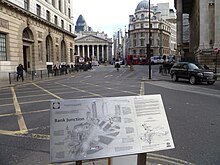Bank junction
| Bank | |
|---|---|

Bank junction in 2012, viewed from Poultry
|
|
| Location | |
| London, United Kingdom | |
| Coordinates: | 51°30′48″N 0°05′21″W / 51.513433°N 0.089045°WCoordinates: 51°30′48″N 0°05′21″W / 51.513433°N 0.089045°W |
| Roads at junction: |
Threadneedle Street, Cornhill, Lombard Street, King William Street, Mansion House Place, Walbrook, Mansion House Street, Queen Victoria Street, Poultry, Prince's Street |
| Construction | |
| Type: | Junction |
| Tolls | Within the London congestion charge zone |
Bank junction is a major road junction in the City of London, the historic and financial centre of London, at which nine streets converge on an area where traffic is controlled by traffic lights and give-way lines. It is named for the nearby Bank of England.
The streets which originate at Bank junction are:
King William Street, a major thoroughfare, begins just south of the junction, leading off Lombard Street.
Standing on the northeast corner of Bank junction is the Bank of England, headquartered on Threadneedle Street since 1734 and thus sometimes known by the metonym The Old Lady of Threadneedle Street, or simply The Old Lady. Across Threadneedle Street and nestled in the gap between Cornhill is the commercial centre the Royal Exchange, founded in 1565 by Thomas Gresham, after whom the nearby Gresham Street is named.
Outside the main entrance to the Royal Exchange is an equestrian statue of the Duke of Wellington overlooking Bank junction; it was inaugurated in June 1844. Also in front of the Royal Exchange is the London Troops War Memorial, commemorating those Londoners who served and died in World War I and World War II.
To the south of the junction is Mansion House. This has been the official residence of the Lord Mayor of London since its completion in 1752. Other notable buildings close to Bank junction include the City of London Magistrates' Court on Walbrook, No 1 Poultry, the Worshipful Company of Grocers, off Prince's Street, and the Worshipful Company of Mercers, on Threadneedle Street.
...
Wikipedia
